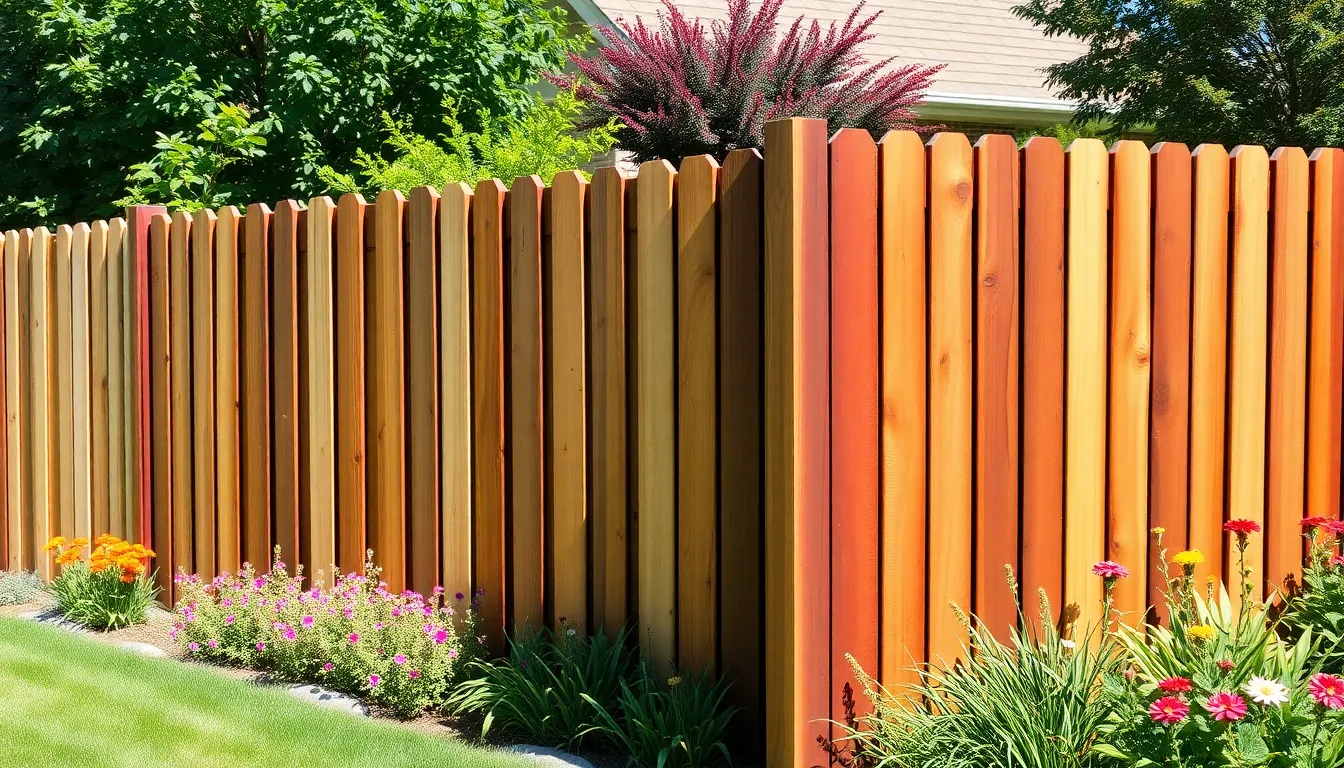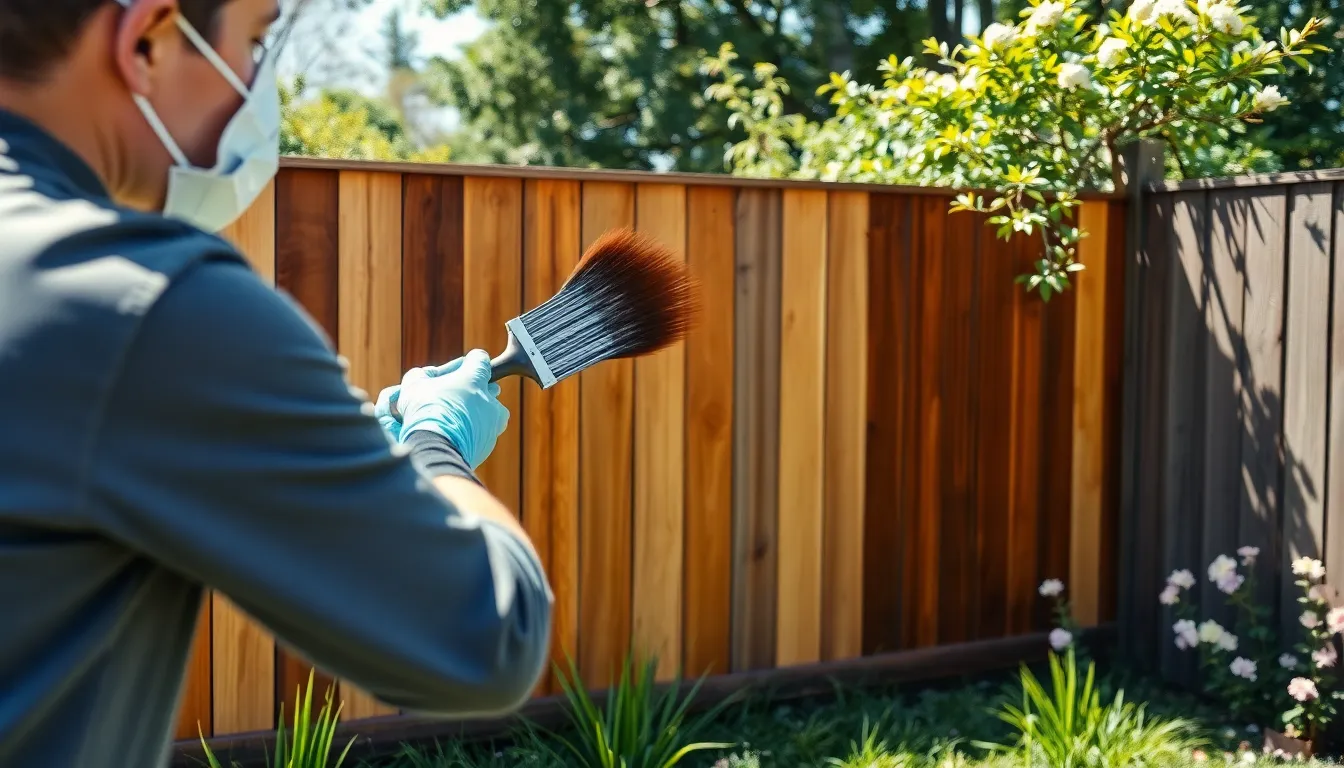A well-maintained fence not only enhances the beauty of a property but also provides essential protection and privacy. Over time, exposure to the elements can lead to fading and deterioration, making fence staining a vital part of upkeep. This simple yet effective process revitalizes the wood, extending its lifespan while adding a fresh pop of color.
Choosing the right stain can transform a dull fence into a stunning focal point in any yard. With various options available, from transparent to solid colors, homeowners have the opportunity to customize their outdoor space. Understanding the benefits and techniques of fence staining can make all the difference in achieving a long-lasting and aesthetically pleasing result.
Table of Contents
ToggleWhat Is Fence Staining?
Fence staining involves applying a specialized treatment to wooden fences to enhance their appearance and protect them from environmental damage. Stains penetrate the wood, providing a barrier against moisture, UV rays, and pests. This process not only prevents fading and deterioration but also enriches the natural beauty of the wood grain.
Fence stains come in various formulations, including oil-based and water-based options, each offering unique benefits. Oil-based stains typically provide deeper penetration and long-lasting protection, while water-based stains tend to dry quicker and have lower volatile organic compounds (VOCs). Homeowners can select transparent, semi-transparent, or solid colors, allowing for individual style preferences while maintaining the fence’s integrity.
Regular fence staining is crucial for extending the life of a fence. Typically, staining should occur every two to three years, depending on climate conditions and the wood type. Proper preparation and application techniques play a vital role in achieving optimal results, ensuring the stained fence resists peeling, cracking, and weather-related damage.
Benefits of Fence Staining

Fence staining provides multiple advantages that contribute to the longevity and appearance of wooden fences.
Protection Against Weather Damage
Staining effectively protects fences from moisture, UV rays, and temperature fluctuations. Stains penetrate wood fibers, forming a barrier that prevents water absorption, reducing the risk of rot and mold. UV protection helps maintain the wood’s natural color, preventing fading over time. Regular staining every two to three years creates an essential protective layer, ensuring the fence can withstand harsh weather conditions and extend its lifespan.
Enhanced Aesthetic Appeal
Staining enhances the natural beauty of wooden fences, allowing homeowners to choose from various shades and finishes. Options range from transparent stains that highlight the wood grain to solid colors that provide a striking look. A well-stained fence complements landscaping and home exteriors, boosting overall property curb appeal. This aesthetic improvement adds value to the home, making it more attractive to potential buyers.
Types of Fence Stains
Fence stains come in various types, each offering unique benefits and characteristics. The two primary categories are oil-based and water-based stains, each catering to specific needs and preferences.
Oil-Based Stains
Oil-based stains penetrate deeply into the wood, providing robust protection against moisture and UV damage. They enhance the wood’s natural beauty while offering long-lasting durability. Homeowners appreciate the rich, vibrant colors that oil-based stains can achieve, often resulting in a more pronounced wood grain appearance. Typically, these stains dry slowly, allowing for an even application and reducing the likelihood of lap marks.
The longevity of oil-based stains often extends beyond that of water-based alternatives, lasting up to five years depending on environmental conditions. Proper ventilation during application is crucial due to the higher volatile organic compounds (VOCs) found in these stains. Regular maintenance, including touch-ups, ensures that oil-based stains continue to perform effectively.
Water-Based Stains
Water-based stains are known for their quick drying time and lower VOC content, making them a more environmentally friendly option. These stains form a protective layer on the surface of the wood, preventing moisture absorption and providing UV resistance. Homeowners benefit from a variety of colors, allowing customization without compromising the wood’s natural characteristics.
Although water-based stains may require more frequent reapplication, typically every two to three years, they allow for easier cleanup with soap and water. These stains provide good protection against mold and mildew growth, ensuring the fence remains resilient in varying weather conditions. Proper preparation and application techniques maximize their performance and longevity.
How to Prepare for Fence Staining
Preparing for fence staining requires careful planning and execution. Proper preparation ensures a successful staining process and enhances the longevity and appearance of the fence.
Choosing the Right Time
Choosing the right time for staining plays a crucial role in achieving optimal results. Stain application should occur in dry weather, with no rain expected for at least 24-48 hours. Early morning or late afternoon periods, when temperatures are cooler, prevent quick evaporation and ensure proper drying. Avoid staining during extreme temperatures, as they can affect stain application and performance.
Necessary Tools and Materials
Gathering the necessary tools and materials before starting the staining process simplifies the task. Essential items include:
- Stain: Select between oil-based or water-based options according to preference.
- Brush or Roller: Use an appropriate applicator for even coverage. Brushes work well for intricate areas, while rollers help speed up the process on flat surfaces.
- Ladder: Ensure safe access to higher fence sections.
- Drop Cloths: Protect surrounding areas from splatters.
- Cleaning Supplies: Use soap, water, and a scrub brush for surface preparation. If there’s mold or mildew, employ a mold cleaner.
- Protective Gear: Wear gloves, goggles, and a mask, especially with oil-based stains, to safeguard against chemicals.
Assembling these tools and materials before starting the project streamlines the process and leads to a professional finish.
Application Process
The application process for fence staining involves meticulous steps that ensure both a professional appearance and optimal protection. Each stage of the process plays a vital role in the overall effectiveness of the stain.
Cleaning the Fence
Cleaning the fence requires removing dirt, grime, and old finishes to ensure proper stain adhesion. He or she should use a pressure washer to eliminate debris effectively, targeting areas with mold or mildew. Applying a wood deck cleaner can facilitate the process, breaking down stubborn stains and ensuring thorough cleaning. Allow sufficient drying time before proceeding, which is typically 24-48 hours depending on weather conditions.
Applying the Stain
Applying the stain involves selecting the right applicator for even coverage. He or she can use a brush, roller, or sprayer, dependent on the stain type chosen. Begin at the top of the fence and work downward to prevent drips and runs. Apply the stain in manageable sections, ensuring even distribution and avoiding over-saturation. Allow the first coat to dry completely, usually 24 hours, before assessing whether a second coat enhances the protection and aesthetic appeal.
Tips for a Successful Finish
Tips for achieving a successful finish include monitoring the weather and choosing a day without rain or high humidity. Selecting high-quality stains ensures better performance and durability. He or she should test the stain on a small, inconspicuous area to confirm the desired color and effect. Working in compatible lighting conditions enhances visibility, helping to identify any uneven spots. Finally, maintain a consistent application technique to achieve a uniform look across the entire fence.
Investing time and effort into fence staining pays off significantly in the long run. It not only protects the fence from the elements but also enhances the overall aesthetic of the property. With a variety of stain options available homeowners can easily find the perfect match for their outdoor spaces.
Regular maintenance through staining ensures the longevity of the fence while preventing costly repairs down the line. By following proper preparation and application techniques homeowners can achieve a professional finish that stands the test of time. Ultimately a well-stained fence adds value and beauty to any home.







